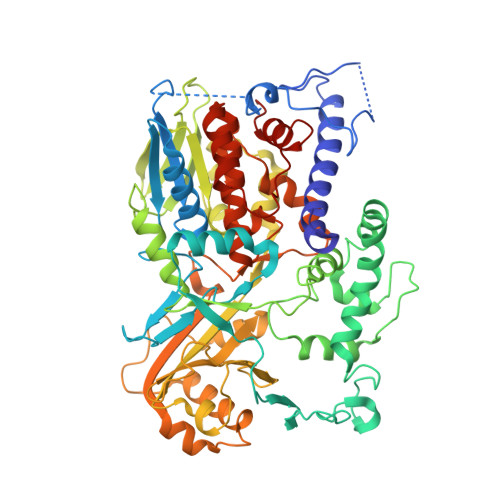Structural basis of enzyme activity regulation by the propeptide of l-lysine alpha-oxidase precursor from Trichoderma viride .
Kitagawa, M., Ito, N., Matsumoto, Y., Saito, M., Tamura, T., Kusakabe, H., Inagaki, K., Imada, K.(2021) J Struct Biol X 5: 100044-100044
- PubMed: 33554108
- DOI: https://doi.org/10.1016/j.yjsbx.2021.100044
- Primary Citation of Related Structures:
7D4C, 7D4D, 7D4E - PubMed Abstract:
Harmuful proteins are usually synthesized as inactive precursors and are activated by proteolytic processing. l-Amino acid oxidase (LAAO) is a flavoenzyme that catalyzes the oxidative deamination of l-amino acid to produce a 2-oxo acid with ammonia and highly toxic hydrogen peroxide and, therefore, is expressed as a precursor. The LAAO precursor shows significant variation in size and the cleavage pattern for activation. However, the molecular mechanism of how the propeptide suppresses the enzyme activity remains unclear except for deaminating/decarboxylating Pseudomonas l-phenylalanine oxidase (PAO), which has a short N-terminal propeptide composed of 14 residues. Here we show the inactivation mechanism of the l-lysine oxidase (LysOX) precursor (prLysOX), which has a long N-terminal propeptide composed of 77 residues, based on the crystal structure at 1.97 Å resolution. The propeptide of prLysOX indirectly changes the active site structure to inhibit the enzyme activity. prLysOX retains weak enzymatic activity with strict specificity for l-lysine and shows raised activity in acidic conditions. The structures of prLysOX crystals that soaked in a solution with various concentrations of l-lysine have revealed that prLysOX can adopt two conformations; one is the inhibitory form, and the other is very similar to mature LysOX. The propeptide region of the latter form is disordered, and l-lysine is bound to the latter form. These results indicate that prLysOX uses a different strategy from PAO to suppress the enzyme activity and suggest that prLysOX can be activated quickly in response to the environmental change without proteolytic processing.
Organizational Affiliation:
Department of Macromolecular Science, Graduate School of Science, Osaka University, 1-1 Machikaneyama-cho, Toyonaka, Osaka 560-0043, Japan.
















